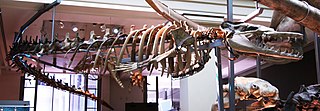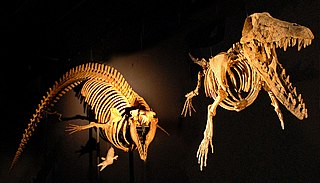This is a list of fossiliferous stratigraphic units in Western Sahara .
Contents
| Formation | Period | Notes |
|---|---|---|
| Samlat Formation | Priabonian | [1] |
| Aridal Formation | Bartonian | [2] |
| Frasnian Formation | Frasnian | [3] |
| Spanish Sahara Formation | Middle Devonian | [4] |
This is a list of fossiliferous stratigraphic units in Western Sahara .
| Formation | Period | Notes |
|---|---|---|
| Samlat Formation | Priabonian | [1] |
| Aridal Formation | Bartonian | [2] |
| Frasnian Formation | Frasnian | [3] |
| Spanish Sahara Formation | Middle Devonian | [4] |

Basilosaurus is a genus of large, predatory, prehistoric archaeocete whale from the late Eocene, approximately 41.3 to 33.9 million years ago (mya). First described in 1834, it was the first archaeocete and prehistoric whale known to science. Fossils attributed to the type species B. cetoides were discovered in the United States. They were originally thought to be of a giant reptile, hence the suffix "-saurus", Ancient Greek for "lizard". The animal was later found to be an early marine mammal, prompting attempts at renaming the creature, which failed as the rules of zoological nomenclature dictate using the original name given. Fossils were later found of the second species, B. isis, in 1904 in Egypt, Western Sahara, Morocco, Jordan, Tunisia, and Pakistan. Fossils have also been unearthed in the southeastern United States and Peru.

Archaeoceti, or Zeuglodontes in older literature, is a paraphyletic group of primitive cetaceans that lived from the Early Eocene to the late Oligocene. Representing the earliest cetacean radiation, they include the initial amphibious stages in cetacean evolution, thus are the ancestors of both modern cetacean suborders, Mysticeti and Odontoceti. This initial diversification occurred in the shallow waters that separated India and Asia 53 to 45 mya, resulting in some 30 species adapted to a fully oceanic life. Echolocation and filter-feeding evolved during a second radiation 36 to 35 mya.
Aramichthys is an extinct genus of prehistoric marine scombrid fish that lived during the middle division of the Eocene epoch. It contains a single species, A. dammeseki from Syria.

Remingtonocetidae is a diverse family of early aquatic mammals of the order Cetacea. The family is named after paleocetologist Remington Kellogg.

Chrysocetus is a genus of extinct early whale known from Late Eocene-aged fossils of the eastern United States and western Africa. It is the second smallest basilosaurid after Saghacetus.
The Qasr el Sagha Formation is a geological formation located in Egypt. The formation is part of the Wadi El Hitan World Heritage Site. The Qasr el Sagha Formation overlies the Birket Qarun Formation and is overlain by the Gebel Qatrani Formation. The sandstones and shales of the formation were deposited in a deltaic to shallow marine environment. It dates to the Late Eocene.

Pappocetus is an extinct protocetid cetacean known from the Eocene of southern Nigeria's Ameki Formation and Togo. More recently, fossil teeth and femurs have also been discovered in the Aridal Formation of the Sahara Desert in southwestern Morocco.
Eocetus is an extinct protocetid early whale known from the early-late Eocene Giushi Formation in Gebel Mokattam, outside Cairo, Egypt. Fossil remains have also been discovered in the Aridal Formation of the Sahara Desert in southwestern Morocco.

The San Jose Formation is an Early Eocene geologic formation in the San Juan Basin of New Mexico and Colorado.

Pterosphenus is an extinct genus of marine snake of the Eocene period.
The Kuldana Formation is a fossil-bearing geological formation of Lutetian age which crops out in northern Pakistan. The abundant fossil remains were deposited by rivers and estuaries crossing an arid to semi-arid environment, between several marine transgressions. Its fossil fauna is best known for the early cetaceans Indohyus, Pakicetus and Ambulocetus, that helped to shed a new light on the evolution of whales, but it also features a large number of early ungulates, rodents and primates.
Aturobatis is an extinct genus of Myliobatiform ray from the Eocene epoch. It contains a single described species, A. aquensis; however, the range of variation in this species is not well understood and it is unclear whether all specimens attributed to the genus are the same species. It is also unknown to which family this genus belongs. The type locality is the Lutetian of southern France. This genus is also known from the Ypresian of the United States, the Lutetian Lisbon Formation of Alabama, and the Priabonian Samlat Formation of Dakhla, Morocco.

The Aridal Formation in the Sahara Desert of southwestern Morocco is a fossil formation with rocks dating to the Lutetian - Priabonian, preserving a middle Eocene shallow coastal environment.